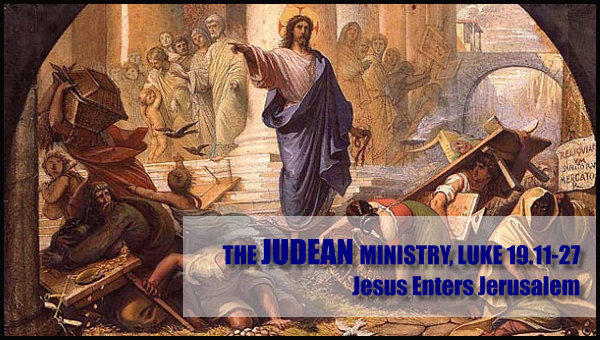By Tyson Thorne

The Judean Ministry at Various Cities (18.1-24.53), 19.28-48
Jesus makes it to Jerusalem! After years of traveling around the country, teaching and performing miracles around Galilee, Samaria and then Judah to prove he is the savior and rightful king of all humanity, he comes to the nation’s capital to complete his mission. Of course, even as his ministry has aligned with prophecy so to must this significant event. As written in Zechariah 9.9: “Rejoice greatly, daughter of Zion! Shout, daughter of Jerusalem! Look! Your king is coming to you: he is legitimate and victorious, humble and riding on a donkey – on a young donkey, the foal of a female donkey.”
After telling the parable of the 10 minas Jesus continued toward Jerusalem. While Luke records they went “up” to Jerusalem, they actually traveled south to get there. This has confused some readers but makes perfect sense to those who grew up in or around my home town of Denver, Colorado. We to use the phrase going up to Colorado Springs, or when in Colorado Springs say going “down” to Denver because Denver is at a lower altitude. One literally travels up to get to Colorado Springs, and the same is true with Jerusalem when coming from Samaria.
Once near the capital city, he sends the disciples out to retrieve a donkey. Jesus was taking advantage of angaria, a custom that permitted one to press an animal into service for a notable individual. This the disciples did, finding a colt where Jesus said they would and took it, explaining to the owner simply that “The Lord has need of it.” There is no more notable person than the Lord, so the owner let them take the animal. The disciples then prepared the donkey to be ridden for the very first time.
Jesus then rode the donkey through the city gate located near the Mount of Olives while his disciples sang praises from the book of Psalms. The people of the city responded in kind, except for the Pharisees who instructed Jesus to rebuke the actions of his followers. Jesus was not inclined to do so. So momentous was the occasion, he claimed that if mankind stood silently by the rest of creation would cry out the truth. The prophecy would be fulfilled!
A short while later Jesus, from a location that provided a view of the city, told of Jerusalem’s future and wept for her. Jerusalem’s demise was not far off, a time when “one stone would not be left on top of another”, was only three or four decades away at most and it troubled him deeply. He continued deeper into the city, eventually making his way into the temple courts.
We should take a moment to address a few noteworthy similarities between the beginning and end of Jesus’ ministry. In the Gospel of John the author very clearly states that at the beginning of his ministry Jesus went into the temple and drove off the money changers and men who sold doves for sacrifice. When asked by what authority, or what sign, he did such things Jesus responds with, “Destroy this temple and in three days I will raise it up again.” The temple he was referring to, of course, was his body but the circumstances and language of John chapter two are very similar to what we find here in Luke and the other synoptic gospels.
Here we see Jesus entering the temple again and, once more, drove out the people selling merchandise. This time, however, there is no confrontation with the authorities and he makes a different statement altogether, “It is written ‘My house will be a house of prayer’ but you have turned it into a den of robbers.” Some point to the two instances as if they were the same and claim the gospel writers contradict each other. After all, John says this happened early in Jesus’ ministry while the others say it happened near the end. In truth, Jesus cleared out the temple twice, bringing a continuity to the beginning and end of his ministry.
|
|